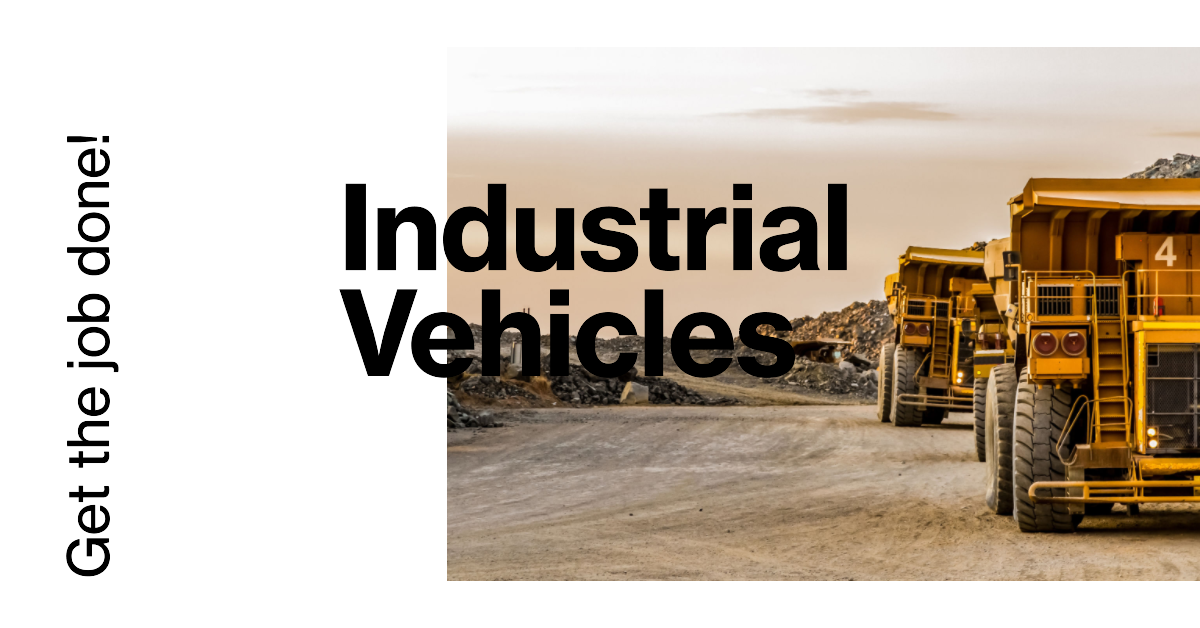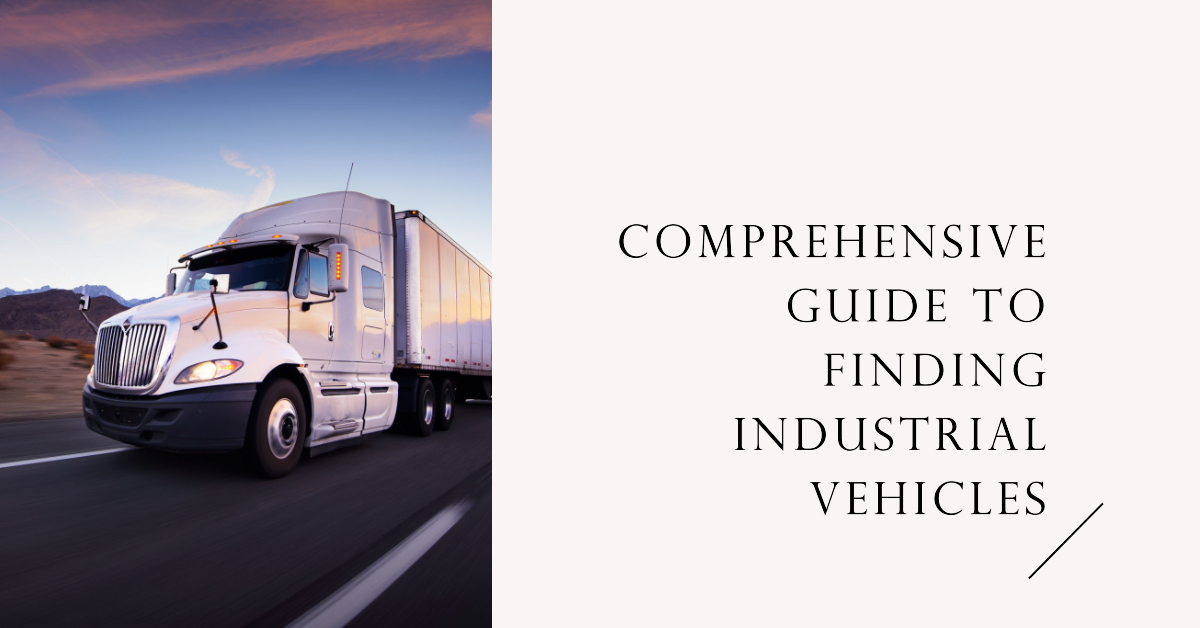- June 12, 2023
Industrial Vehicles

A Comprehensive Guide to Finding Industrial Vehicles:

Introduction:
Industrial vehicles play a crucial role in various sectors, from construction and manufacturing to logistics and agriculture. Finding the right industrial vehicle for your specific needs can be a challenging task. This guide aims to provide you with a step-by-step approach to finding the ideal industrial vehicle, ensuring that you make an informed decision.
I. Assessing Your Requirements:
Before embarking on your search for industrial vehicles, it’s important to assess your specific requirements. Consider factors such as the intended application, load capacity, terrain conditions, and any specialized features you may need. By understanding your needs clearly, you can narrow down your options and focus on vehicles that are best suited for your purposes.
II. Researching Industrial Vehicle Types:
Industrial vehicles come in various types, each designed for specific tasks. Some common types include forklifts, cranes, bulldozers, excavators, and dump trucks. Conduct thorough research on these different types to understand their capabilities, limitations, and the industries they serve. This knowledge will help you determine which type of industrial vehicle is most suitable for your requirements.
III. Exploring Manufacturers and Suppliers:
Identifying reputable manufacturers and suppliers is crucial in finding high-quality industrial vehicles. Look for companies with a proven track record, positive customer reviews, and a wide range of options. Check if they offer after-sales support, warranty, and spare parts availability. Take the time to compare prices, features, and services offered by different manufacturers to ensure you get the best value for your investment.
IV. Considering New vs. Used Vehicles:
Decide whether you prefer purchasing a new or used industrial vehicle. New vehicles offer the advantage of the latest technology, warranty coverage, and potentially longer service life. However, used vehicles can be a cost-effective option if you have budget constraints. When considering used vehicles, thoroughly inspect their condition, maintenance history, and ensure they meet safety standards. Consulting with a trusted mechanic or an expert in industrial vehicles can provide valuable insights during this process.
V. Evaluating Total Cost of Ownership:
While the initial purchase cost is important, it’s equally crucial to consider the total cost of ownership throughout the vehicle’s lifespan. Factors such as fuel consumption, maintenance requirements, spare parts availability, and depreciation should be taken into account. Consider vehicles with good fuel efficiency, low
maintenance costs, and easy availability of spare parts to optimize your investment in the long run.
Discovering Different Types of Industrial Vehicles:

I. Forklift Trucks:
Forklift trucks are versatile industrial vehicles designed for material handling tasks. They are commonly used in warehouses, distribution centers, and manufacturing facilities. Forklift trucks are equipped with hydraulic forks that lift and transport heavy loads. These vehicles come in various types, including counterbalance forklifts, reach trucks, and order pickers, each suited for specific applications.
II. Excavators:
Excavators are heavy-duty construction vehicles used for digging, excavation, and earthmoving tasks. They consist of a bucket, boom, and cab mounted on a rotating platform known as the “house.” Excavators are available in different sizes and configurations, such as crawler excavators, wheeled excavators, and mini excavators, catering to diverse construction requirements.
III. Bulldozers:

Bulldozers are powerful industrial vehicles primarily used in earthmoving and leveling operations. Equipped with a wide and heavy blade at the front, bulldozers can push large quantities of soil, rubble, or other materials with ease. These vehicles are commonly seen on construction sites, mining areas, and road-building projects. Variants of bulldozers include crawler bulldozers and wheeled bulldozers, each suitable for specific terrains and tasks.
IV. Cranes:

Cranes are indispensable vehicles employed for lifting and moving heavy objects. They feature a tall tower or mast with cables, pulleys, and a hook or grabber. Cranes come in various types, such as tower cranes, mobile cranes, and crawler cranes. Tower cranes are commonly used in construction sites, while mobile cranes are versatile and can be transported to different locations. Crawler cranes are ideal for rough terrains and large-scale lifting operations.
V. Dump Trucks:
Dump trucks are specialized vehicles designed for transporting loose materials, such as sand, gravel, or construction debris. They feature a hydraulically operated open-box bed that can be raised at an angle to unload the contents. Dump trucks come in different configurations, including standard dump trucks, articulated dump trucks, and off-road dump trucks. These vehicles find applications in construction sites, mining operations, and waste management tasks.
VI. Pallet Jacks:

Pallet jacks, also known as pallet trucks, are small industrial vehicles used for moving pallets or skids within warehouses and distribution centers. They feature forks that can be slid under pallets, allowing for easy transportation. Pallet jacks come in manual and electric variants, with the latter offering powered movement and lifting capabilities. These vehicles are essential for efficient material handling in logistics operations.
Exploring the Diversity of Industrial Vehicles:
1. Construction Vehicles:
1.1 Excavators: These heavy-duty vehicles are used for digging, demolition, and earthmoving tasks on construction sites. They come in various sizes and configurations, including tracked and wheeled versions. 1.2 Bulldozers: Equipped with a large metal blade in the front, bulldozers are employed for pushing, leveling, and clearing debris at construction sites. 1.3 Cranes: Vital for lifting and moving heavy materials and equipment, cranes are available in diverse forms such as tower cranes, crawler cranes, and mobile cranes.
2. Material Handling Vehicles:

2.1 Forklifts: Widely used in warehouses and manufacturing facilities, forklifts designed for lifting and transporting heavy loads. 2.2 Conveyor Systems: These automated systems facilitate the movement of materials within a facility, enhancing efficiency in manufacturing and distribution processes.
2.3 Pallet Jacks: Also known as pallet trucks or pump trucks, these vehicles utilized for moving palletized loads horizontally.
3. Agricultural Vehicles:
3.1 Tractors: Considered the backbone of agriculture, tractors perform a variety of tasks such as plowing, tilling, and harvesting crops.
3.2 Combine Harvesters: These self-propelled machines specifically designed for harvesting grain crops, reducing labor-intensive processes.
3.3 Sprayers: Agricultural sprayers used for applying fertilizers, pesticides, and herbicides to crops, ensuring optimal growth and yield.
4. Transportation Vehicles:
4.1 Trucks: From delivery and distribution to hauling heavy goods, trucks versatile vehicles used across various industries.
4.2 Freight Trains: Efficiently transporting large quantities of goods over long distances, freight trains are an integral part of the logistics industry.
4.3 Cargo Ships: These vessels facilitate global trade by transporting goods and materials across oceans and waterways.
5. Specialized Vehicles:

5.1 Mining Trucks: Specifically designed for mining operations, these trucks have the capacity to carry large quantities of materials over rough terrains.
5.2 Airport Ground Support Equipment: From baggage loaders to aircraft tugs, these vehicles assist in various ground operations at airports.
5.3 Utility Vehicles: Primarily used in maintenance and repair tasks, utility vehicles provide mobility and convenience for workers in various industries.
A Comprehensive List for Workplace Safety:
Category 1: Warning Signs:

Warning signs are crucial in alerting individuals to potential hazards associated with industrial vehicles. They communicate important messages that caution people to exercise caution and be mindful of their surroundings. Here are some common warning signs used in industrial settings:
1. Danger: High Voltage
– Warns individuals of high voltage areas near industrial vehicles.
2. Caution: Watch for Moving Vehicles
– Alerts people to be cautious of vehicle movement.
3. Warning: Forklift Traffic
– Highlights areas where forklifts frequently operate.
4. Caution: Blind Spot
– Reminds individuals to be aware of vehicle blind spots.
5. Danger: Falling Objects
– Indicates areas prone to falling objects, requiring caution.
Category 2: Prohibition Signs:

Prohibition signs help communicate actions strictly prohibited to ensure safety in industrial vehicle zones.Used to restrict access, prevent accidents, and maintain a safe work environment. Here some commonly used prohibition signs:
6. No Unauthorized Personnel
-Only authorized allowed in designated areas.
7. No Pedestrians
– Prohibits pedestrian access in areas with vehicle traffic.
8. No Smoking
-Smoking not allowed due to potential fire hazards.
9. No Mobile Phones
– Prohibits the use of mobile phones to avoid distractions near industrial vehicles.
10. No Food or Drinks
– Discourages eating or drinking in vehicle areas to prevent contamination.
Category 3: Instruction Signs:

Instruction signs provide essential guidance for individuals operating industrial vehicles or interacting with them. These signs communicate specific actions or procedures to follow to ensure smooth operations and minimize risks. Here are some examples of instruction signs:
11. Stop
– Signals vehicle operators to halt at specific points or intersections.
12. Yield to Pedestrians
– Instructs vehicle operators to give pedestrians the right-of-way.
13. Speed Limit
– Specifies the maximum speed allowed for vehicles in a particular area.
14. Sound Horn
– Reminds drivers to sound their horns to alert pedestrians or other vehicles.
15. Keep Clear
– Instructs individuals to keep a designated area clear for smooth vehicle movement.
Category 4: Emergency Signs:

Emergency signs are crucial for swiftly responding to potential accidents or incidents involving industrial vehicles. These signs help individuals identify emergency equipment and follow proper procedures in case of an emergency.
16. Emergency Assembly Point
-The designated location for employees to gather during emergencies.
17. Fire Extinguisher
– Identifies the location of fire extinguishers near industrial vehicle areas.
18. Emergency Exit
– Guides individuals to emergency exits in the event of an evacuation.
19. First Aid Station
– Points to the location of the nearest first aid station or medical facility.
20. Emergency Shut Off
– Highlights the location of emergency shut-off switches for vehicles or machinery.
Conclusion:
Above all.Industrial vehicle signs are indispensable for maintaining workplace safety and preventing accidents in industrial settings.Prioritizing the implementation of these signs contributes significantly to a safer work environment
